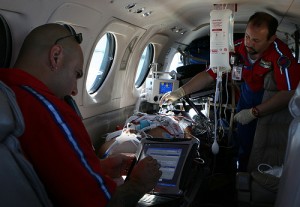Research Canadian Health Care Mall: The Role of Aeromedical Transport
Aeromedical transport (AMT) of seriously ill patients is no longer a rarity, but rather an everyday event. Indeed, as early as 1784, after the balloon flight demonstrations of the Montgolfier brothers, physicians began to consider the benefits their patients could gain from flight. Jean-Francois Picot theorized that not only could patients tolerate balloon flight, they would in fact benefit from purer air encountered at altitude. AMT using heavier-than-air machines was initiated in 1909, when Captain George Gosman built a plane specifically for this purpose. 
However, it was not easy to convince the government to approve further development of Gos-man’s aircraft following its destruction in a crash, and it was never used to transport actual patients. In 1917, the French Dorand AR II was the first air ambulance that actually carried patients. Over the next several decades, the “ambulance airplane” industry grew, mainly in the military. World War II saw great increases in the use of AMT. It has been estimated that more than one million patients were airlifted by the United States from all theaters of this conflict, with an overall death rate of only 4 in 100,000.
The Korean War brought new challenges and opportunities for AMT. In 1950, the use of the helicopter for the front-line medical evacuation of patients during combat was authorized. More than 17,000 patients were transported by Army helicopters alone from January 1951 to 1953. The outstanding medical evacuation system developed during the war in Vietnam owed much to the experience gained during the Korean conflict. The effective use of helicopters for AMT in Vietnam and their appearance almost nightly on domestic television kindled interest in their use for air evacuation in the civilian community. The recent conflict in the Persian Gulf has also emphasized the importance of AMT in military operations.
The marriage of aviation and medicine has expanded the reach of the critical care unit and other specialized units beyond an individual hospital. The incorporation of monitoring, ventilators, oxygen and suction, infusion pumps, etc, allows critical care therapy similar to that available within the hospital. Unfortunately, many advertised “air-ambulance” services are nothing more than business aircraft staffed by a moonlighting paramedic or nurse obtained on a “catch-as-can” basis by a charter aircraft company. There may be no medical direction at all and thus no practice standards, appropriate education of personnel, quality assurance, or medical control.
Canadian Prescription MedStore online – www.acanadianhealthcaremall.com.